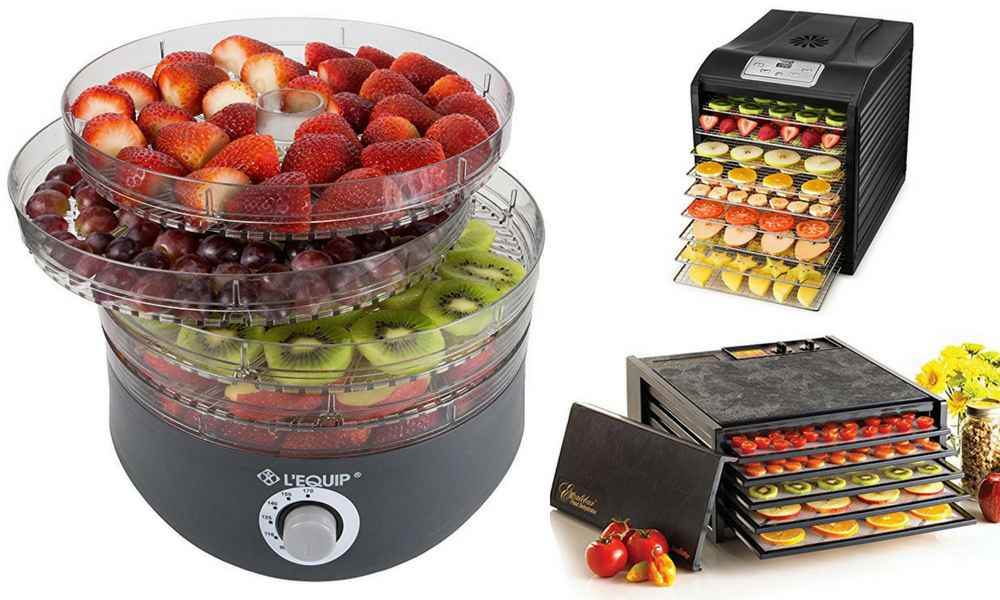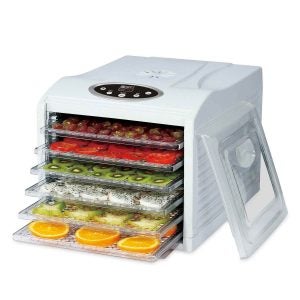Food Dehydrator Buyer’s Guide—Choosing the Best for Yourself
Are you looking for a food dehydrator? Whether a pro or a novice, buying a new dehydrator is always a nerve-wrecking decision. After all, materials, wattage, size, and capacity, these are all important factors you need to consider before buying a food dehydrator. But even then, it doesn’t have to be. Yes, there are a lot of options on the market, a lot of factors to consider. However, sometimes it’s all about a little research effort…which we’re guessing is exactly how you ended up here.
Not to worry, we understand that sifting through product information and countless reviews is not only time-consuming, but it can also leave you more confused than you were to start with. That’s exactly why we’ve compiled a food dehydrator buyer’s guide. Our guide has all the information you need in one place to make the right decision.
Types of Food Dehydrators
There are two main types of food dehydrators that are available on the market, and the differ based on design. Now, we’re not talking aesthetics, instead the design difference we’re talking about is the direction of the air flow in each of them. The first ones you need to think of are vertical food dehydrators. As the name suggests, they have a vertical air flow. Their fan and heating element are placed either on the bottom or top, pushing the air above or below, but in either case, the direction remains vertical. These dehydrators are round in shape and the most common in consumer market. Particularly popular amongst beginners just embarking on their food dehydration journey, these dehydrators are compact, stackable, and easy to use. Some even compress for storage, making them a great choice or everyday kitchen use. Another key factor about these dehydrators is their affordable price tag. Quite a few standout vertical food dehydrators are available under $100 on the market.
Next up, we have the horizontal food dehydrators. They come in the shape of a box, and they have rectangle or square trays. Instead of circulating air from the top to bottom or vice versa, hot air in these dehydrators comes from the fan in the rear. These dehydrators are larger, heavier, and more suitable for commercial or heavy-duty use, though many purchase the cheaper versions for home use. They also have more capacity than the vertical food dehydrators, and typically a stronger motor for faster and more efficient drying.
What to Look for In Food Dehydrators
When it comes to picking out the best food dehydrator out there, it will largely depend on your individual needs and preferences. Not all people want to use a food dehydrator for the same range of recipes or with the same frequency of use. So, the first thing you should do before moving ahead is determine the purpose of your purchase. Do you want to dry foods in big batches, make beef jerky, or use your machine for crafts? Once you know exactly how this kitchen appliance is meant to assist you, go ahead and read our list of features below. You need to keep this checklist in mind and match it with your requirements before making a purchase to be sure that you end with a gadget that you can use for a long time to come.
Size
Dehydrators come in all sizes and shapes. If you have a small kitchen or storage space for this machine is going to be an issue, the horizontal food dehydrator will probably be a bad fit. Stackable round dehydrators take less space and are easy to put away!
Wattage
Food dehydrators are usually energy-efficient by default, but considering their long running time, it doesn’t hurt to go for lower wattage. Unless you want your dehydrator to be faster and more powerful than most regular models; in which case you need to get a higher wattage model. Now, the wattage differs in every model of dehydrator you pick. But as a rule of thumb, horizontal dehydrators are more powerful than vertical dehydrators. Nonetheless, be sure to check!
Capacity
Do you plan on making small batches of snacks or want to dehydrate produce in bulk to feed a large family? For most households, a small vertical dehydrator will do the trick with the usual 4 to 6 trays that come with the appliance. There’s also the option for expanding your vertical dehydrator by adding more trays. In fact, some models go up to 20 trays, so you know that your dehydrator can evolve alongside your skills and needs! However, if you plan on doing serious drying from the get go, invest in a larger, horizontal model.
Materials
Dehydrators are made with both plastic and stainless steel. Both are good options. But here’s the catch. Stainless steel dehydrators are expensive, typically forged into a shelf-like horizontal design. Of course, they are sturdier, reliable, and more durable. The plastic models on the other hand are much cheaper, often available below $100. They are preferred by novices in comparison to the stainless steel dehydrators which are preferred by professionals.
Bonus Features
Other factors that you should consider are the on and off switch, temperature controller, and in-built timer. Some dehydrators are built to be easy to use and therefore do not come with anything except an on and off switch. In fact, some low-price dehydrators don’t even have that. But, if you don’t mind shelling out a little more money, you can get all the bells and whistles, including the automatic shut off, timers, digital touch settings, and LED displays.
What more? Consider the accessories that come with the dehydrator. Some include a jerky gun, fruit roll sheets, and mesh screens. These are great if you want versatility from your dehydrator. Not to say, you can’t make a variety of recipes without these accessories, but they’re definitely something you can factor in.
So, there you have it. All the things you need to know before you purchase a food dehydrator. Now, go ahead, take that leap. We assure you, it’ll be worth it.



